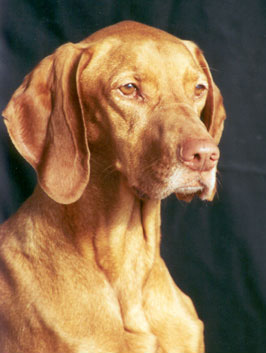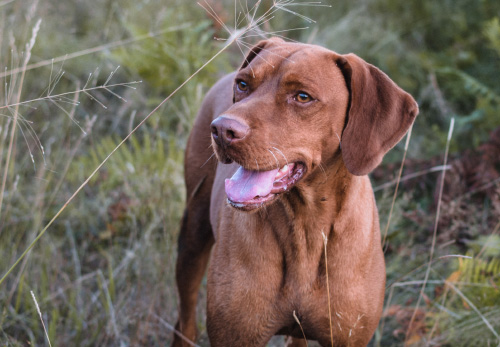
Smooth Vizsla
Group: Sporting Dogs
Origin: Hungary
Height:
– Male: 23 inches (58 cm)
– Female: 22 inches (56 cm.)
Weight:
– Male: 50 to 65 lbs (22.5-29.5 kg)
– Female: Approx. 10 lbs (5 kg) less
Also Known As: Hungarian Pointer; Hungarian Short-haired Pointer; Rövidszörü Magyar Vizsla

CD, AgX, CGC, TT, RPT, OAC, NGC, NJG
Photo courtesy of: GUIDES CANINS
CLICK HERE to View Breeder Listings
Breed Profile
The Vizsla, also known as the Hungarian Pointer, is perfectly suited to perform the duties of a pointer and retriever and is now considered the national dog of Hungary. The breed was imported into North America during the 1950s and gained recognition by the American Kennel Club in 1960. The Canadian Kennel Club officially recognized the breed into the Sporting Group shortly thereafter.
In North America, the Vizsla is used primarily as an upland bird dog, renowned for his excellent scenting and retrieving abilities. He is a eager and happy hunter in the field and a strong swimmer that retrieves well from water.
The Vizsla is intelligent, obedient, sensitive and easy to train, as well as gentle-mannered and affectionate. He is very loyal and devoted to his family and may display strong protective instincts.
Known as one of the most versatile breeds in the world — The first triple champion (show, field and obedience) in the history of the American Kennel Club was a Vizsla! In addition to being a excellent pointer and retriever, the Vizsla excels in competitive obedience, agility, flyball, tracking as well as in the show ring. His calm and sensitive nature also make him a good candidate to work as a therapy dog as well as hearing and guide dog.
His coat is short, smooth, dense and close-lying with a glossy sheen. Sometimes called the “Yellow Pointer”, his colouring is a golden-rust. He conveys the impression of an alert, muscular, well-balanced dog with a distinctive and aristocratic appearance.
Health Issues
The Vizsla is generally known as a healthy breed. However, like all breeds, certain genetic disorders have been seen within the breed, these include:
- Hip Dysplasia
- Epilepsy
- Eye diseases — including progressive retinal atrophy (PRA), cataracts, and entropion.
- Congenital Heart Disease
- Thyroid disorders
- von Willebrand’s Disease
If you are considering the adoption of a Vizsla puppy, or any breed, it is very important to be selective in choosing a responsible and reputable breeder. Ensure that the prospective puppy’s parents have all health clearances. Breeding of any dog should not be done until after they have been proven to be free of evidence of significant hereditary diseases. For the Vizsla, health clearances should include OFA, OVC or PennHIP certified clear of Hip Dysplasia; CERF certification for eyes diseases; as well as testing and clearances for Thyroid disorders, and Congenital Heart Disease. (For more information on selecting a breeder, see the articles on the main General Information page.)
Additional Health Resources:
- Vizsla Health – From the Vizsla Club of America
- Canine Health Information Center (CHIC) — Providing a source of health information for owners, breeders, and scientists that will assist in breeding healthy dogs. CHIC is a centralized canine health database jointly sponsored by the AKC/Canine Health Foundation (AKC/CHF) and the Orthopedic Foundation for Animals (OFA).
- Health and Nutrition — Growing section of the Canada’s Guide to Dogs website which includes information on several health and nutrition related issues.
- AKC Canine Health Foundation — Working towards developing scientific advances in canine health.
- Canine Eye Registration Foundation (CERF)
- Orthopedic Foundation for Animals (OFA)
- Ontario Veterinary College (OVC)
- University of Pennsylvania Hip Improvement Program (PennHip)
- HealthGene — HealthGene Corporation is the leading provider of veterinary DNA diagnostic services in Canada.
- Labgenvet — Laboratory of Veterinary Genetics is a Canadian diagnostic laboratory that offers a comprehensive service of DNA tests for veterinary genetic diseases.
Breed Standards
- CKC Breed Standard
- AKC Breed Standard
- UKC Breed Standard
- The Kennel Club (U.K.) Breed Standard for the Hungarian Vizsla
- FCI Breed Standard No. 57 – Hungarian Short-haired Pointer (Vizsla) (Rövidszörü Magyar Vizsla)

Grooming Information
The Vizsla’s smooth coat requires minimal grooming. General, frequent brushing will maintain the coat in a shiny and healthy condition.
- Grooming — This section of the Canada’s Guide to Dogs website includes tips, articles and information covering all aspects of dog grooming along with a listing of Groomers from across Canada.
Training Resources
The Vizsla is sensitive by nature, eager to please, intelligent, and learns quickly. The best training methods are always through positive reinforcement, gentle correction, consistency and patience.
- Training — For training information, see this growing section of the Canada’s Guide to Dogs website for tips, articles, as well as listings of training centres across Canada.
Additional Information
- Clubs, Sports & Activities — This section of the Canada’s Guide to Dogs website covers several sports and activities and also includes listings of non-breed specific Dog Clubs from across Canada.
- Working Dogs — The Working Dogs section of the Canada’s Guide to Dogs website provides information and listings of organizations that are involved in various dog jobs, such as Guide Dogs, Therapy Dogs, Police Dogs, Protection Dogs, and much more.
- www.vizsladogs.com — Online Vizsla encyclopedia.
*NOTE 1: CHIC – The Canine Health Information Center “is a database of consolidated health screening results from multiple sources. Co-sponsored by the Orthopedic Foundation for Animals (OFA) and the American Kennel Club (AKC) Canine Health Foundation, CHIC works with parent clubs to identify health screening protocols appropriate for individual breeds. Dogs tested in accordance with the parent club established requirements, that have their results registered and made available in the public domain are issued CHIC numbers.” To learn more, visit: www.caninehealthinfo.org
*NOTE 2: The Fédération Cynologique International (FCI) is the World Canine Organization, which includes 91 members and contract partners (one member per country) that each issue their own pedigrees and train their own judges. The FCI recognizes 344 breeds, with each being the “property” of a specific country. The “owner” countries write the standards of these breeds in co-operation with the Standards and Scientific Commissions of the FCI, and the translation and updating are carried out by the FCI. The FCI is not a breed registry nor does it issue pedigrees.
Breed Listing
Quick Links
Get In Touch
- Email: canadasguidetodogs@gmail.com
- Email: info@canadasguidetodogs.com
- Visit us on Facebook: www.facebook.com/CanadasGuideToDogs
— CanadasGuideToDogs.com is an Amazon Associate as well as a participant in various affiliate programs, as such fees are earned from qualifying purchases.
